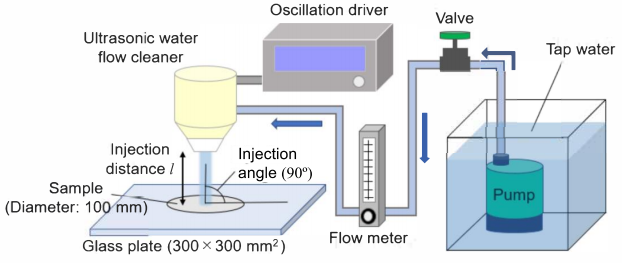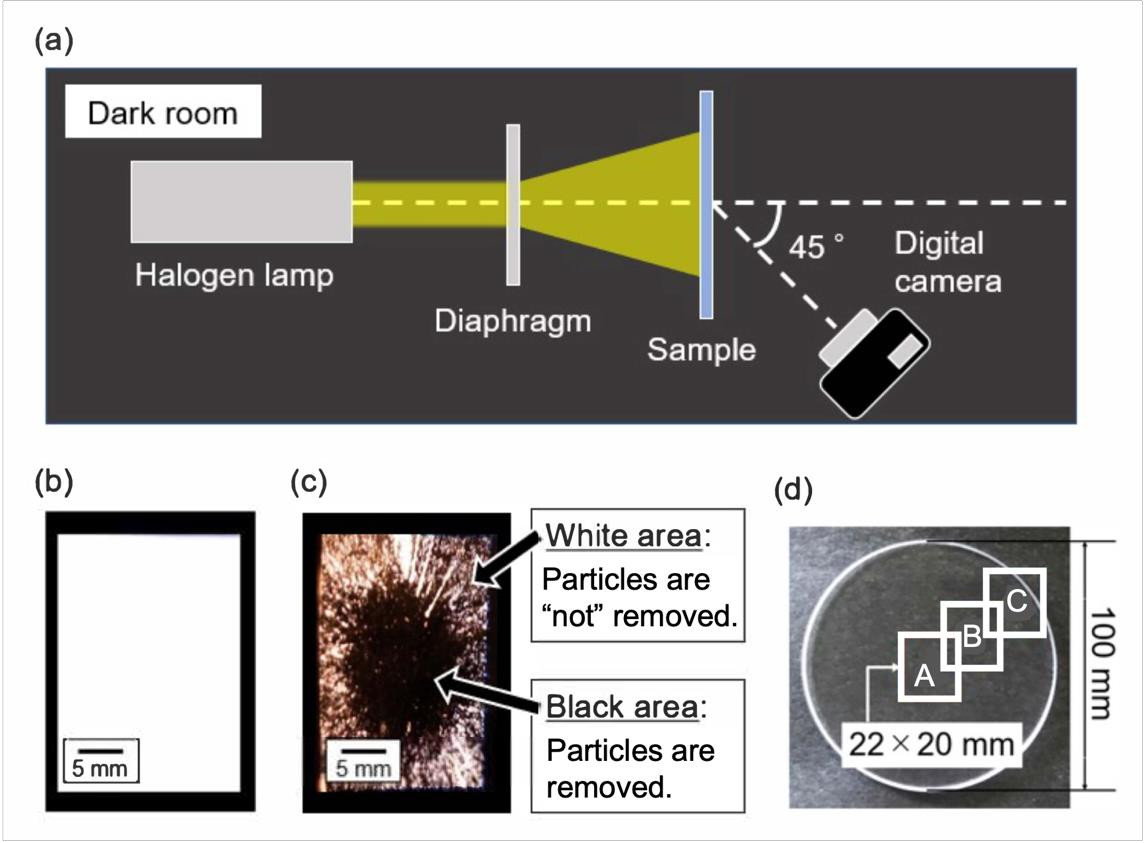Abstract.
Cleaning tests with ultrasound-superposed water jets are performed to explore the optimal injection distance from the jet nozzle to a glass plate spin-coated with small silica particles (as a cleaning sample). The cleaning performance is evaluated based on particle removal efficiency (PRE) that is calculated using the haze method. Visualization of the water jet and liquid film flow over the cleaning target shows that the jet flow with short injection distance tends to be in a steady state, while the water jet shape instability grows for long injection distance, leading to atomization of the jet. The cleaning tests with varying the injection distance suggest that there exists an optimal injection distance at which the PRE becomes maximal.
Introduction
In the post-CMP cleaning process in semiconductor manufacturing, very small contaminant particles need to be removed from silicon wafers. A promising technique for effective post-CMP cleaning is ultrasonic water flow cleaning. In this technique, ultrasound-superposed water jets are set into collision against cleaning targets and the hydrodynamic force acting on attached particles is expected to contribute to particle removal . From visualization of 0.43 MHz or 0.95 MHz ultrasound superposed water jets and the subsequent film flow spreading over glass surfaces , cavitation bubbles are found to play a key role in particle removal as in the conventional method with ultrasound cleaning baths. To be specific, motion of near-wall cavitation bubbles can produce strong wall shear stress and thus augment the cleaning performance. In this study, we perform ultrasonic water flow cleaning tests with varying the injection distance (from the jet nozzle to a cleaning target) and explore the optimal condition at which the cleaning performance becomes maximal.
Experimental Method
The experimental setup for ultrasonic water flow cleaning is depicted in Fig. 1. Tap water at 25C is pumped, at flow rate 2.0 L/min, to an ultrasonic water flow cleaner (QUAVA Spot 27220, KAIJO; 20W) to produce a 0.95 MHz ultrasound superposed water jet that is injected through a circular nozzle of 8 mm in diameter. The Reynolds number for the circular water jet is 5200. The downward jet is then set into collision against a circular glass plate (of 100 mm in diameter and 1 mm in thickness) spin-coated with silica particles of 0.25 m in diameter (MS-B200, MIKASA). The injection distance l from the jet nozzle to the cleaning sample is treated as a parameter, exploring its optimal value to maximize the cleaning performance of the ultrasound-superposed water jet collision.

Figure 1: Schematic of the ultrasonic water flow cleaning test. The frequency and input power of the ultrasound are 0.95 MHz and 20 W, respectively. The cleaning sample is a glass plate (100 mm in diameter) spin-coated with silica particles (0.25 m in diameter). The injection distance l is treated as a parameter (10 mm to 200 mm).
After the 60-s ultrasonic water flow cleaning, we evaluate the cleaning performance based on particle removal efficiency (PRE). As depicted in Fig. 2(a), light scattering from the sample (before and after the cleaning) in a dark room is capture by a digital camera at 45 from back illumination by a halogen lamp; this is the so-called haze method. The light passes through a rod homogenizer and shows a rectangular projected area on the sample; see Fig. 2(b,c). Average intensity of the light scattering is calculated by ImageJ (National Institutes of Health). We define PRE based on the intensity values before and after the cleaning; PRE = 0% means no particle removal, while PRE = 100% means that all particles are removed. To obtain spatial distributions of the cleaning performance, we define PRE at three different domains A to C as depicted in Fig. 2(d); the domain A is set at the center of the sample, while the domain C is close to the edge of the sample.

Figure 2: Evaluation of the ultrasonic flow cleaning efficiency based on the haze method. (a) Optical system for the measurement of particle removal efficiency (PRE). (b, c) Image of the light scattering from the sample before and after cleaning. (d) PRE evaluation domains.
Results and Discussion
Before examining the cleaning tests and PRE results, we first present visualization of the ultrasound-superposed water flow. The shape of the water jet is unstable as in the images captured with LED backlighting (Fig. 3). In this visualization, we used sufficiently large distance l for the effect of jet collision to be negligible. It turns out that capillary instability grows as the jet is advected from the nozzle exit. The jet radius r fluctuates because of the shape instability; the fluctuation is emphasized in the downward direction. After the jet collision against the cleaning sample, a radially spreading film flow is formed. For the case of l = 20 mm, a stationary hydraulic jump appears in the upstream side of the sample edge as in Fig. 4(a). The thickness of the film before the hydraulic jump occurred is approximately 1 mm; the corresponding Reynolds number for the film flow is on the order of 100. However, as the distance l gets larger, the position of the hydraulic jump shows fluctuation due to the unstable shape of the jet. It is also instructive to note that the shape instability gives rise to jet atomization under the ultrasound irradiation as seen in Fig. 4(b) where the image was captured with a black background; the atomization will result from interaction between acoustic cavitation and the jet interface and can be seen as mist consisting of very small water droplets.

Figure 3: Representative images of the water jet at different distance measured from the nozzle exit. The incident ultrasound (0.95 MHz) propagates through the jet (from the top to bottom in these images).

Figure 4: Visualization of the ultasound-superposed water jet. (a) The jet collision and film flow over the sample for the case of injection distance l = 20 mm. A stationary hydraulic jump appears in front of the sample edge (as depicted in the right-hand side). (b) Water jet atomization under the ultrasound irradiation.
Summary
The PRE results show that there exists an optimal injection distance to maximize the cleaning performance of ultrasonic water flow cleaning. If the injection distance is too short, the jet collision and film flow with a hydraulic jump tend to be in a steady state, giving rise to reduced PRE in the jet collision spot and in the vicinity of the sample’s edge (where the liquid film gets thicker because of the stationary hydraulic jump). If the injection distance is too long, the acoustic energy of the ultrasound dissipates due to the jet atomization. Hence, we may say that the optimal injection distance is determined from these trade-off relations.
上一篇: 光刻技术和机器的发展